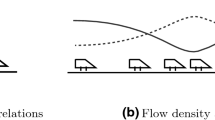Abstract
We solve numerically the integrodifferential equation for the equilibrium case of Paveri–Fontana's Boltzmann-like traffic equation. Beside space and actual velocity, Paveri–Fontana used an additional phase space variable, the desired velocity, to distinguish between the various driver characters. We refine his kinetic equation by introducing a modified cross section in order to incorporate finite vehicle length. We then calculate from the equilibrium solution the mean-velocity–density relation and investigate its dependence on the imposed desired velocity distribution. A further modification is made by modeling the interaction as an imperfect showing-down process. We find that the velocity cumulants of the stationary homogeneous solution essentially only depend on the first two cumulants, but not on the exact shape of the imposed desired velocity distribution. The equilibrium solution can therefore be approximated by a bivariate Gaussian distribution which is in agreement with empirical velocity distributions. From the improved kinetic equation we then derive a macroscopic model by neglecting third and higher order cumulants. The equilibrium solution of the macroscopic model is compared with the cumulants of the kinetic equilibrium solution and shows good agreement, thus justifying the closure assumption.
Similar content being viewed by others
REFERENCES
M. J. Lighthill and G. B. Whitham, Proc. R. Soc. London Ser. A 229:317 (1955); G. B. Whitham, Linear and Nonlinear Waves(Wiley & Sons, 1974).
B. Kerner and P. Kohnhäuser, Phys. Rev. E 48:R2335 (1993).
D. Helbing, Physica A 219:375 (1995); Physica A 219:391 (1995).
G. F. Newell, Oper. Res. 9:209 (1961).
M. Bando et al., J. Phys. I France 5:1389 (1995).
K. Nagel and M. Schreckenberg, J. Phys. I France 2:2221 (1992).
K. Nagel, Phys. Rev. E 53:4655 (1996).
T. Nagatani, Physica A 218:145 (1995); Phys. Rev. E 51:92 (1995).
I. Prigogine and R. Herman, Kinetic Theory of Vehicular Traffic(Elsevier, New York, 1971).
C. Wagner et al., Phys. Rev. E 54:5073 (1996).
S. L. Paveri-Fontana, Trans. Res. 9:225 (1975).
W. F. Phillips, Rep. No. DOT/RSPD/DPB/50-77/17, Mech. Eng. Dept., Utah State University, Logan Utah, 1977 (unpublished); Rep.No. DOT-RC-82018, Utah State University, Logan Utah, 1981 (unpublished).
E. Barone and A. Belleni-Morante, Trans. Theory Stat. Phys. 7(1&2):61 (1978).
R. Semenzato, Trans. Theory Stat. Phys. 9(1&2):83-93 (1981); 9(2&3):95–114 (1981).
E. Alberti and G. Belli, Trans. Res. 12:33 (1978).
S. Chapman and T. G. Cowling, The Mathematical Theory of Nonuniform Gases(Cambridge University Press, Cambridge, 1952).
P. P. J. M. Schram, Kinetic Theory of Gases and Plasmas(Kluwer Academic Publishers, Dordrecht, 1991).
P. Resibois, J. Stat. Phys. 19(6):593 (1978).
P. Nelson, Trans. Theory Stat. Phys. 24:383 (1995).
R. Kühne, in Highway Capacity and Level of Service, U. Brannolte, ed. (Balkema, Rotterdam, 1991), p. 211, In Proc. 9th Inter. Symp. on Transportation and Traffic Theory, I. Volmuller and R. Hamerslag, eds. (VNU Sciences Press, Utrecht, The Netherlands, 1984).
H. Zackor, R. Kühne, and W. Balz, Untersuchungen des Verkehrsablaufs im Bereich der Leistungsfähigkeit und bei instabilem Fluss(Forschung Straßenbau und Straßverkehrstechnik, Bonn, 1988), p. 524.
R. Wegener and A. Klar, A kinetic model for vehicular traffic derived from a stochastic microscopic model, preprint; A. Klar and R. Wegener, J. Stat. Phys. 87:91 (1997).
D. Helbing, Physica A 233:253 (1996).
A. Mason and A. Woods, Phys. Rev. E 55:2203 (1997).
P. Wagner, K. Nagel, and D. Wolf, Physica A 234:687 (1997).
Author information
Authors and Affiliations
Rights and permissions
About this article
Cite this article
Wagner, C. Traffic Flow Models Considering an Internal Degree of Freedom. Journal of Statistical Physics 90, 1251–1275 (1998). https://doi.org/10.1023/A:1023231428403
Issue Date:
DOI: https://doi.org/10.1023/A:1023231428403




